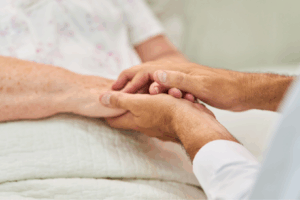By Chris Wallner, Chief Marketing Officer, Institute on Aging
When my father’s wife passed away, I faced a challenge familiar to many adult children: how to support an aging parent who wishes to remain independent while ensuring their safety and well-being. This challenge became even more complex during the pandemic, when physical visits were limited, and I lived 1.5 hours away. Technology became the bridge that allowed my father to stay in his home for an additional 2.5 years before transitioning to an assisted living community closer to me.
Like many families, the pandemic added layers of complexity to caregiving. Physical distance, combined with my father’s dementia and his need to manage 14 different medications daily, made finding solutions more urgent. Through trial, error, and persistence, I discovered a set of technology tools that allowed me to remotely monitor and manage his care while giving him independence and dignity.
Although I am not formally endorsing specific products, here are the tools that made a difference—and the one that truly stood out.
A Game-Changer: Wi-Fi Enabled Automated Pill Dispenser
Managing medications for someone with dementia is no small feat. After experimenting with various options, I landed on the MedaCube automated pill dispenser, which became a critical tool in extending my father’s time at home.
The Wi-Fi-enabled design allowed me to ensure he took the right medications at the right times, even from miles away. It provided peace of mind for me and consistency for him—something no other solution could replicate.
Creating a Smarter, Safer Home
Beyond medication management, several other smart devices helped me support my father’s independence while ensuring his safety:
- Wyze Wi-Fi Cameras, Smart Locks, and Thermostat: I put cameras in strategic locations, such as the kitchen refrigerator, the bottom of the stairs, and other places around the house that my father frequented, all which enabled me to visually confirm he was safe. A “smart” front door lock and thermostat provided added convenience and control. The remote door lock, equipped with a keypad, also enabled me to manage access to the home for caregivers, ensuring they could enter and leave as needed, and eliminate access to caregivers who moved on.
Learn more at Wyze. - Remote Lighting Controls: Gosund smart switches automated lighting in his home, ensuring pathways were well-lit without the need for manual intervention.
- LED Night Lights: Simple yet effective, Solatec plug-in night lights with auto dusk-to-dawn sensors helped prevent nighttime falls.
- Apple Watch for Location Monitoring and Fall Detection: Knowing I could track his location and be alerted in case of a fall was invaluable. Learn more about Apple Watch features.
- Rachio Remote Irrigation Timer: For his peace of mind, the Rachio irrigation timer kept his yard watered without requiring him to manage it manually.
Lessons Learned
Looking back, the Wi-Fi enabled automated pill dispenser stood out as the most essential piece of technology. Everything else, while helpful, was secondary. These tools together created an environment where my father could safely age in place, even during a time of isolation and uncertainty.
If you’re navigating similar challenges, consider these options. While every family’s needs are unique, the right tools can make a world of difference in maintaining a loved one’s independence and your own peace of mind.
Technology gave my father—and our family—two and a half years of additional cherished time in his home. I hope this inspires and helps others on the same journey.





